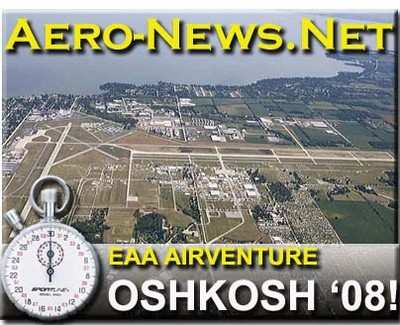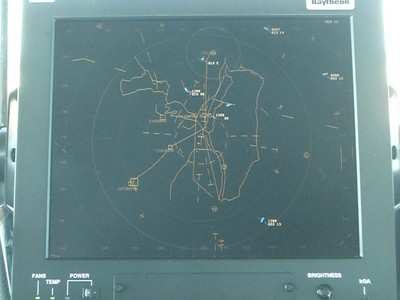Why Does MKE Handle Wittman Traffic?
by ANN Correspondent Dave Slosson
Since February 14, 2008, the airspace over Oshkosh has been
controlled by Milwaukee Approach control, instead of Chicago
Center. Apparently, Chicago Center wanted to open a new sector for
the southbound routes into O'Hare International Airport and needed
to divest themselves of this low-level area.

Since Oshkosh is closer to Green Bay than to Milwaukee (35 vs.
68 nautical miles), we asked Wanda Adelman, Oshkosh Tower Manager
during AirVenture, why Milwaukee took over the airspace instead of
Green Bay. In a nutshell, it's because of equipment capability and
existing space.
Milwaukee has a radar display system called STARS, which stands
for Standard Terminal Automation Replacement System. Part of that
system is installed in control towers that don't have any radar,
but whose airport lies within the approach control's boundary.
STARS has a capability no other terminal automation system with the
National Airspace System (NAS) possesses, called multi-mode. This
is the ability to take more than one radar input and display it to
the controller simultaneously. The radar controller in this case
uses the feeds from Milwaukee, Green Bay, and Madison terminal
radars plus Horicon's long-range radar to create a mosaic, or joint
picture on his radar scope. Of course, since these displays are all
high-resolution, color, solid-state and square, calling it a radar
scope like the old days is kind of outdated. It's now termed a
controller workstation.
The tower displays are a smaller version with fewer capabilities
than the radar displays, mounted either in the main tower like at
Milwaukee, or remote towers like Oshkosh. The display in Oshkosh
tower is called a TDW, for Tower Display Workstation. This allows
the controllers at Oshkosh tower to see the aircraft around them in
the air, to a point.
Adelman said the additional information available to the tower
controllers has been a real boon. "With a transponder aircraft we
can see down to about 200 feet AGL (above ground level), the
primaries about 1100 feet and that works really well for us."
Before, the arrival aircraft flying by instruments would be
verbally coordinated with the Oshkosh tower controllers, and they'd
have to find them visually to be able to separate them from other
traffic. Now, they're displayed on the flat-panel display and
tagged with the N-number or call sign of the aircraft, and the
controllers can watch them almost until touchdown. This is a huge
safety improvement and will eliminate many delays during instrument
weather (less than 3 miles visibility or ceilings less than 1000
feet).
During AirVenture specifically, the controllers talking to the
arrivals can use the information to know when to extend the
downwind stream to follow the straight-in stream. No more relying
on pilot reports of position, which tended to be inaccurate due to
pilot workload or forgetting what was requested. There is also
silent coordination of the instrument arrivals between controllers
since they're tagged on the TDW. This eliminates a minimum of two
calls per instrument arrival, one from approach to the tower for
the arrival information and one from the tower to the approach
controller that the aircraft has landed. The procedures for the
instrument departures have not been changed for this year, but more
calls can probably be eliminated in the future. Since the TDW also
allows most of the surrounding aircraft to be seen, wayward
aircraft have a better chance of being spotted and conflicts
averted.

Milwaukee received the STARS system due to the volume of
aircraft it works. Green Bay's operations are not near the volume
of Milwaukee's, and it was a budget decision by the FAA in 2005
that only level 8 facilities and above would receive the STARS.
Green Bay is a level 7, all determined by annual traffic count and
specific airspace issues, such as controlling a Military Operations
Area adjacent or not. Milwaukee also had the space to run another
controller workstation, where Green Bay does not.
So Oshkosh got lucky... with a brand new tower and new
capabilities that will enhance controller and pilot operations
year-round for many years to come.
 ANN's Daily Aero-Term (04.24.24): Runway Lead-in Light System
ANN's Daily Aero-Term (04.24.24): Runway Lead-in Light System ANN's Daily Aero-Linx (04.24.24)
ANN's Daily Aero-Linx (04.24.24) Aero-FAQ: Dave Juwel's Aviation Marketing Stories -- ITBOA BNITBOB
Aero-FAQ: Dave Juwel's Aviation Marketing Stories -- ITBOA BNITBOB Classic Aero-TV: Best Seat in The House -- 'Inside' The AeroShell Aerobatic Team
Classic Aero-TV: Best Seat in The House -- 'Inside' The AeroShell Aerobatic Team Airborne Affordable Flyers 04.18.24: CarbonCub UL, Fisher, Affordable Flyer Expo
Airborne Affordable Flyers 04.18.24: CarbonCub UL, Fisher, Affordable Flyer Expo




